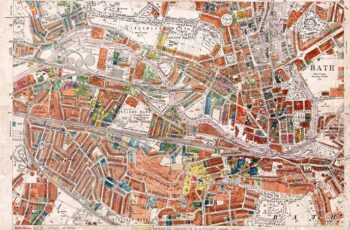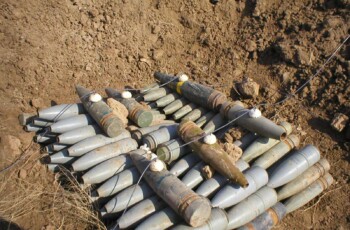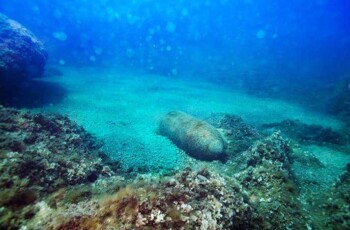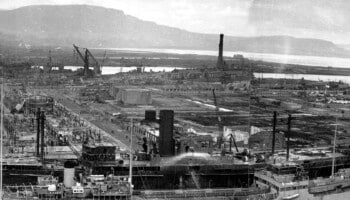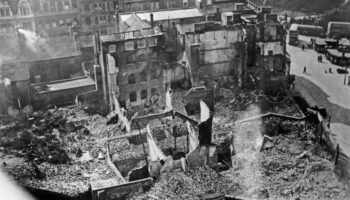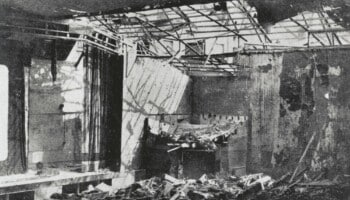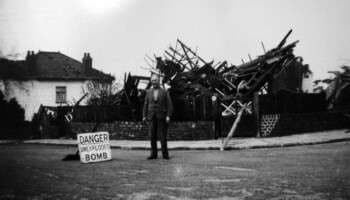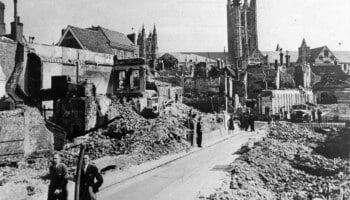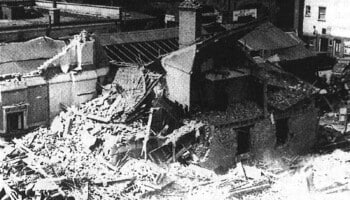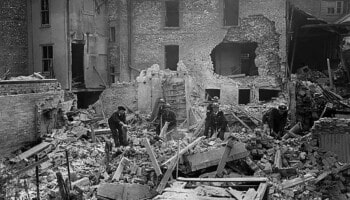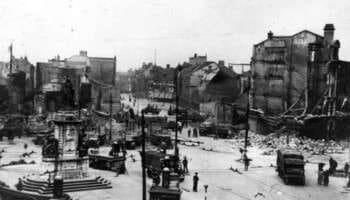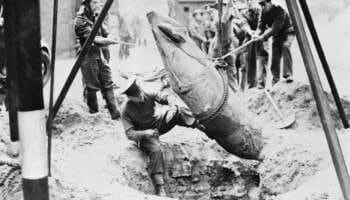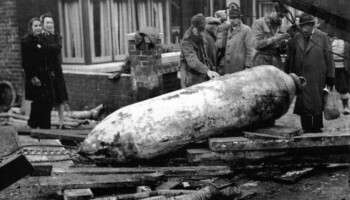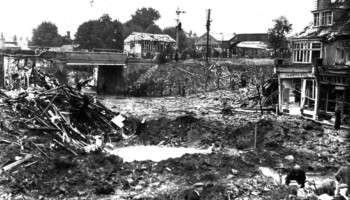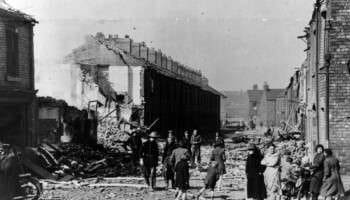Home » Resources » UXO City Guides »
UXO City Guide
Home Office Bombing Statistics for Cardiff
Record of German Ordnance dropped on the County Borough of Cardiff
High Explosive Bombs (All types)
536
Parachute Mines
26
Oil Bombs
0
Phosphorus Bombs
0
Fire Pots
25
Pilotless Aircraft (V-1)
0
Long-range Rocket Bombs (V-2)
0
Weapons Total
587
Area Acreage
14,050
Number of items per 1,000 acres
41.7
Why was Cardiff targeted and bombed in WWII?
On the face of it Cardiff may not be considered the most obvious place to have been targeted for sustained bombing, with bigger and more industrially important cities such as London, Birmingham, Coventry and Hull at the forefront of the Luftwaffe’s attention.
However, due to Cardiff containing one of the biggest coal ports in the world during a time where coal was an essential fuel resource – Cardiff docks were targeted heavily during WWII. The Welsh city was not just important for industry, commerce and trade but was also crucial for much needed supplies to reach Britain from across the Atlantic during WWII.
Home Office Bombing Statistics for Cardiff
Over the course of the war, air raid sirens were sounded 585 times in Cardiff, with a total of 355 people killed and 502 people injured.
Details recorded by the official Home Office bombing statistics, indicates the volume and type of bombs that fell on the County Borough of Cardiff throughout WWII.
A total of 587 recorded bombs fell on Cardiff, equating to 41.7 items of ordnance per 1,000 acres.
Major bombing raids on Cardiff
While the last few months of 1940 brought several bombing raids over other Welsh towns and cities, the most devastating attacks on Cardiff came on 2nd January 1941. The full moon or ‘Bomber’s moon’ that night, set the stage for the worst bombing Wales had experienced to date.
The wail of the air raid sirens was soon followed by the sound of bomber aircraft over the city as they crossed the Severn estuary. The first bombs struck at 6.37 pm and continued to fall over a period of ten hours1.
Around 150 people were killed and dozens of buildings and homes were destroyed – and the day is commonly referred to as the Cardiff Blitz (due to the German ‘Blitzkrieg’, meaning ‘Lightning War’).
This included major Cardiff landmarks such as Llandaff Cathedral, which sustained extensive damage to both the church itself and its immediate area due to multiple parachute mines being dropped in its vicinity.
Further examples of the volume of ordnance dropped on the city can be found in a localised incident within the Riverside community of Cardiff. This air raid took place, once again on 2nd January 1941, killing 50 people on De Burgh Street2.
Fortunately, local bombing incidents were recorded with some examples shown in the damage damage map below.
Can UXO still pose a risk to construction projects in Cardiff?
Whilst Cardiff did not sustain as much bombing as other major cities in the UK, due to the presence of its docks and industry, it was still significantly targeted. The majority of bombing occurred on and around the docks, but the surrounding residential areas were also affected.
The primary potential risk from UXO in Cardiff is from items of German air-delivered ordnance which failed to function as designed. Approximately 10% of munitions deployed during WWII failed to detonate, and whilst efforts were made during, and after the war to locate and make UXBs safe, not all items were discovered. This is evidenced by the regular, on-going discoveries of UXO during construction-related intrusive ground works across the UK – not just in Cardiff.
Occasionally items of British explosive ordnance are also encountered – such as the projectile which was found at Companies House, adjacent to former Maindy Barracks on Whitchurch Road in 2013, or the anti-tank shell encountered on Pethybridge Road, Ely, Cardiff in 2007.
I am about to start a project in Cardiff, what should I do?
Developers and ground workers should consider this potential before intrusive works are planned, through either a Preliminary UXO Risk Assessment or Detailed UXO Risk Assessment. This is the first stage in our UXO risk mitigation strategy and should be undertaken as early in a project lifecycle as possible in accordance with CIRIA C681 guidelines
It is important that where a viable risk is identified, it is effectively and appropriately mitigated to reduce the risk to as low as reasonably practicable (ALARP).
However, it is equally important that UXO risk mitigation measures are not implemented when they are not needed.
While there is certainly potential to encounter UXO during construction projects in Cardiff, it does not mean that UXO will pose a risk to all projects. Just because a site is located in Cardiff does not mean there is automatically a ‘high’ risk of encountering UXO. It really does depend on the specific location of the site being developed.
A well-researched UXO Risk Assessment will take into account location specific factors – was the actual site footprint affected by bombing, what damage was sustained, what was the site used for, how much would it have been accessed, what were the ground conditions present etc.
It should also consider what has happened post-war – how much development has occurred, to what depths have excavations taken place and so on. This will allow an assessment of the likelihood that UXO could have fallen on site, gone unnoticed and potentially still remain in situ.
Recent UXO discoveries in Cardiff
Since the war, many items of Unexploded Ordnance (UXO) have been discovered across multiple cities within the UK, with Cardiff no exception.
- In January 2023, a ‘small ordnance device’ was discovered at Lamby Way centre: https://www.walesonline.co.uk/news/wales-news/recycling-centre-evacuated-after-street-26030084
- In February 2020, Cardiff streets were evacuated as bomb disposal team rush to Penarth, near Cardiff, following the discovery of a suspected military ordnance: https://www.express.co.uk/news/uk/1243572/Cardiff-news-bomb-disposal-team-police-Wales-Barry-Road-delays-Penarth
- In 2014, an unexploded WWII high explosive mortar was found at Kenfig Pool, Bridgend (near Cardiff): https://www.bbc.co.uk/news/uk-wales-south-east-wales-28912887
- In August 2013, a dummy UXO was discovered at Maindy Barracks: https://www.walesonline.co.uk/news/wales-news/staff-evacuated-after-unexploded-wwii-5777021
- In April 2007, an anti-tank shell was unearthed at Pethybridge Road, Ely: https://www.walesonline.co.uk/news/wales-news/bomb-squad-drama-war-shell-2260279
All of these incidents were promptly investigated by the Police and/or local bomb disposal experts to minimise the risk and avoid any potential damage to surrounding buildings and local infrastructure.
Get UXO risk mitigation services from a partner you can trust
UXO City Guides
Got a project in Cardiff? Not sure if there's a UXO risk? Need advice but not sure where to start?
If you need general advice about UXO risk mitigation in Cardiff, contact us and we’ll be happy to help.
Call: +44 (0) 1992 245020 or Email: info@1stlinedefence.co.uk
Contact Us
* indicates required fields
